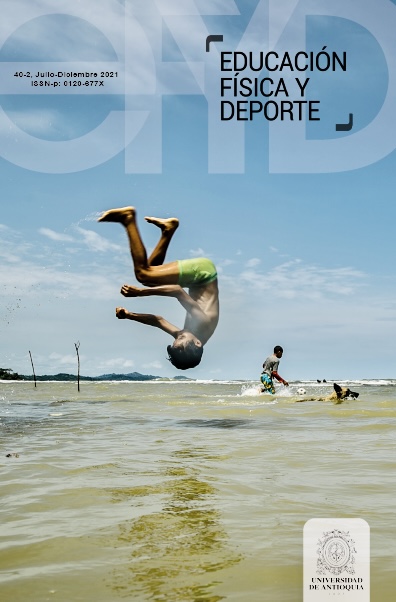Analysis of the Use of Contemporary Art in the Methodology of a Physical Education Teacher
DOI:
https://doi.org/10.17533/udea.efyd.v40n2a03Keywords:
Action research, autobiographical storie, physical education, contemporary artAbstract
The purpose of this work is to analyze the teaching methodology based on the use of contemporary art by a physical education teacher. The qualitative methodology has been used through an action research with 10 autobiographical stories of the researcher made from 2009 to 2019, 53 autobiographical stories of students and the analysis of 20 discussion groups with high school students. The results show the different relationships that have been established with art throughout teaching, which is specified in four categories that show the different forms of application of art in physical education: art as reproduction, art as provocation, art as metaphor and art as atmosphere. In addition, the importance of resignifying the use of art in our classrooms and incorporating the analysis of the voices of the students in the research-action processes to improve our professional practices is concluded.
Downloads
References
1. ATLAS.ti Scientific Software Development. (2011). ATLAS.ti 6 User Guide and Reference. https://atlasti.com/wp-content/uploads/2014/05/atlasti_v6_manual.pdf
2. Bernad Lage, S. (2017). Atmósfera activa. Hacia una poética y política del espacio contemporáneo. Centre Universitari de Disseny i Art de Barcelona.
3. Betrián Villas, E., Galitó Gispert, N., García Merino, N., Jové Monclús, G., & Macarulla Garcia, M. (2013). La triangulación múltiple como estrategia metodológica. REICE. Revista Iberoamericana sobre Calidad, Eficacia y Cambio en Educación, 11(4), 5-24. https://revistas.uam.es/index.php/reice/article/view/2869
4. Biesta, G. J. J. (2010). Good Education in an Age of Measurement: Ethics, Politic, Democracy. Paradigm Publishers.
5. Camnitzer, L. (2014). Un saber realmente útil: pensar en torno al arte y a través de él. Museo Nacional Centro de Arte Reina Sofía.
6. Dewey, J. (1934). El arte como experiencia. Paidós.
7. Ferrando, B. (2012). Arte y cotidianeidad: hacia la transformación de la vida en arte. Árdora Exprés.
8. García-Puchades, W., & Chiva-Bartoll, Ó. (2018). El juego como proceso de subjetivación y su justificación en el currículum de EF. Cultura, Ciencia y Deporte, 13(38), 147-156. http://dx.doi.org/10.12800/ccd.v13i38.1070
9. Grzymala, M. (2017). Orbital Motion [instalación]. Espai d’Art Contemporani de Castello, Castellón, Valencia.
10. Harman, G. (2016). Inmaterialism: Objects and Social Theory. Polity Press.
11. Hernández, F., & Rifà, M. (coords.). (2011). Investigación autobiográfica y cambio social. Editorial Octaedro.
12. Holt, N. (1976). Sun Tunnels [instalación escultórica]. Desierto de Utah.
13. Jové, G. (coord.). (2006). Desig d’alteritat. Programa Àlber: una eina per a l'atenció a la diversitat a l’aula. Pagès Editors.
14. Jové Monclús, G., Betrián Villas, E., Ayuso Moli, H., & Vicens, L. (2012). Proyecto «Educ-arte-Educa(r)t”: espacio híbrido. Pulso, (35), 177-196. https://dialnet.unirioja.es/servlet/articulo?codigo=4118871
15. Larrosa, J. (2003). Entre las lenguas. Lenguaje y educación después de Babel. Editorial Laertes.
16. Leggo, C. (2010). Lifewriting: A Poet’s Cautionary Tale. LEARNing Landscapes, 4(1), 67-84. https://doi.org/10.36510/learnland.v4i1.363
17. López Secanell, I. (2018). Otro arte/otra educación física: los diálogos de una profesora entre la educación física y el arte abstracto. Educación Física y Deporte, 37(2), 205-242. https://doi.org/10.17533/udea.efyd.v37n2a05
18. López Secanell, I. (2021). Aprendiendo Educación Física en torno al arte contemporáneo. INDE.
19. López-Secanell, I., & Jové-Monclús, G. (2017). (De)Construyendo la Educación Física mediante ambientes de aprendizaje de arte contemporáneo. Ágora para la Educación Física y el Deporte, 19(2), 226-256. https://doi.org/10.24197/aefd.2-3.2017.226-256
20. Martínez Vendrell, N., & López Secanell, I. (2020). La expresión corporal en Educación Física: análisis del interés del alumnado de secundaria. EmásF. Revista Digital de Educación Física, (64), 8-19. https://emasf.webcindario.com/Expresion_corporal_y_musica_en_EF.pdf
21. Meerzon, Y. (2005). Body and space: Michael Chekhov’s notion of atmosphere as the means of creating space in theatre. Semiotica, (155), 259-279. https://doi.org/10.1515/semi.2005.2005.155.1-4.259
22. Rancière, J. (1996). El desacuerdo. Política y filosofía. Nueva Visión.
23. Ruiz de Velasco Gálvez, A., & Abad Molina, J. (2019). El lugar del símbolo. El imaginario infantil en las instalaciones de juego. Editorial GRAÓ.
24. Uberti, M. (2015). Drawing of a drawing 2 [instalación]. Design Miami, Miami, Florida.
Published
How to Cite
Issue
Section
License
Copyright (c) 2021 Irene López Secanell

This work is licensed under a Creative Commons Attribution-NonCommercial-ShareAlike 4.0 International License.











